First Aid – Broadhead in Leg!
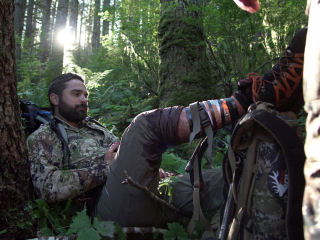
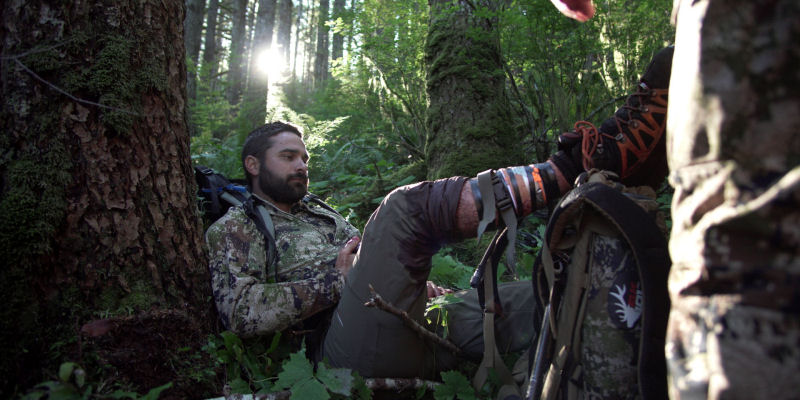
Last week, we released Episode 9 of the Elk Talk Podcast, which included my conversation with David Brinker about the “broadhead in the leg” incident that we experienced while hunting Roosevelt elk together in Oregon. If you haven’t had a chance to listen to this Episode, it’s worth a listen. Click one of the links below to check it out now:
On Youtube
On iTunes
On Stitcher
On Google Play
In a nutshell, David and I, along with Donnie Drake and cameraman John Abernathey, were hiking into a remote drainage in the thick coastal region of Oregon hoping to find Roosevelt elk. We were around 2.5 miles from the truck, when David tripped on a thick tangle of huckleberry brush. At the same time, the brush dislodged an arrow from his quiver, and in a flash, David was on the ground with a broadhead-tipped arrow stuck in his calf.
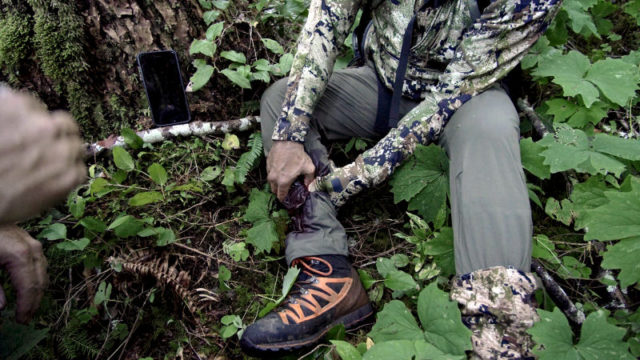
Donnie, John, and I were 40 or 50 yards ahead of David when he called out and vocally let us know he had cut himself, and that he needed help. Unsure of what had happened, we rushed up to find an arrow lying on the ground next to David, who was also on the ground gripping his lower leg that was soaked in blood – a lot of blood.
I’m not a paramedic by any means, and I’ve not had much practice in these kinds of situations. My mind raced and wanted to quickly jump ahead to options for transporting David out of the backcountry, but I knew we had more immediate work to take care of. And based on the amount of blood we were seeing, it needed to be taken care of fast!
Just 2 weeks earlier, I had recorded a short “What’s In My Pack” video for my friends at EXO packs (click here to see that video). For the video, I pulled all my gear from my loaded backpack and went through each piece that I carry on my standard elk hunting trips. At the end, almost as an afterthought, I remembered I had a small first-aid kit in the bottom of my backpack and pulled it out to give it a brief honorable “mention”. I think I said something to the effect of, “I’ve never had to use this, but it’s small and light, so I keep it in my pack anyway.” Famous last words…
David’s pant leg was soaked from just below his knee, all the way down into his boot. The 2” long, razor-sharp broadhead had penetrated through his gaiter, his outer pants, and his base layer, and buried past the ferrule into the large calf muscle just behind his shin bone. David couldn’t remember if he pulled the arrow out, or if it was tugged out by the brush that initially tangled it up in the first place, but the arrow was lying on the ground next to him when we walked up to him. I quickly placed it in a notch in a nearby tree to make sure no one else stepped on it as we went to work.
As I dug into my pack there on the huckleberry-brush-infested hillside, I knew I didn’t have anything in my simple first-aid kit that was going to be helpful in this situation. In fact, in retrospect, the first-aid kit I was carrying was only good for “comfort” measures….bandaids, moleskin, Tylenol – oh yeah, and a small bottle of super glue. All of these items seemed worthless in this situation.
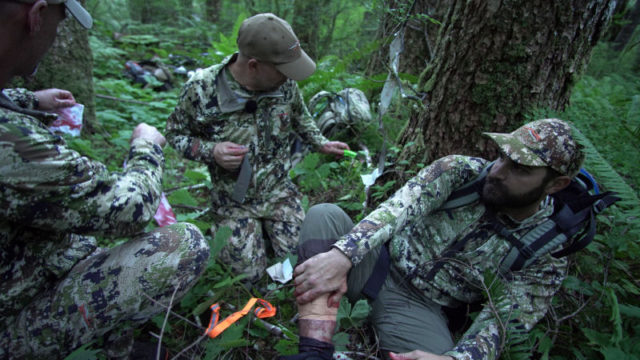 I knew we had to get the bleeding stopped. That was Priority #1, and based upon the amount of blood we were seeing, we probably needed to act fast. My mind raced through the items in my backpack, and within a few seconds, I had pulled my Havalon knife and Ovis Sack game bags from my “Kill Kit”, and started shredding the game bag into strips that could be used to bandage the wound. I folded one of the strips up in to a 3” x 3” “patch, and placed it over the wound. Then, we wrapped another game bag strip around that patch. A roll of electrician’s tape was wrapped around the center of the strip to hold it in place, and as I reached for the roll of Leukotape in my pack to attach the bandage to David’s leg, the initial patch and bandage slipped down on David’s calf and blood came gushing out of the wound.
I knew we had to get the bleeding stopped. That was Priority #1, and based upon the amount of blood we were seeing, we probably needed to act fast. My mind raced through the items in my backpack, and within a few seconds, I had pulled my Havalon knife and Ovis Sack game bags from my “Kill Kit”, and started shredding the game bag into strips that could be used to bandage the wound. I folded one of the strips up in to a 3” x 3” “patch, and placed it over the wound. Then, we wrapped another game bag strip around that patch. A roll of electrician’s tape was wrapped around the center of the strip to hold it in place, and as I reached for the roll of Leukotape in my pack to attach the bandage to David’s leg, the initial patch and bandage slipped down on David’s calf and blood came gushing out of the wound.
We had to start over, this time with instructions to hold the bandage in place until it had been secured to David’s leg. Another patch, another strip, the electrical tape, and then the Leukotape at the top and bottom of the strip of game bag. This was just the start, and I knew this would not apply the needed pressure to actually stop the bleeding. We duplicated the process, and soon had another patch and strip of game bag wrapped around his leg, again affixed with electrical tape and Leukotape.
At this point, I felt we had the wound “contained”, but also knew that we needed to somehow apply pressure for a period of time to allow the bleeding to clot. Looking through our packs, we pieced together enough items to make a makeshift compression apparatus – a strap extender from Donnie’s pack, and a Bic lighter from mine. I placed the lighter directly over the wound, and then tightened the strap extender down snug to apply constant pressure through the lighter and onto the wound.
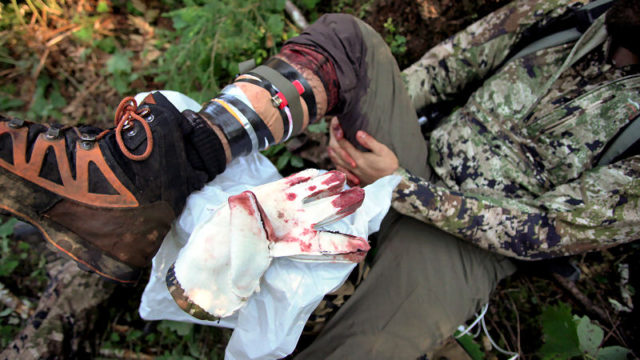 During all of this, David asked if he was going to be OK. Honestly, having never been in this situation prior, I wasn’t sure. I had successfully tracked elk and found them lying dead with less blood than what we had here. And as Donnie was holding his thumbs (yes, two thumbs on the hole to apply the initial pressure) over the wound, he could feel the blood pumping against his thumbs trying to push out of the hole the broadhead had left in the side of David’s calf. However, I calmly told David it was only a “flesh wound”, and that he was going to be just fine. We all managed to stay incredibly calm – at least on the surface.
During all of this, David asked if he was going to be OK. Honestly, having never been in this situation prior, I wasn’t sure. I had successfully tracked elk and found them lying dead with less blood than what we had here. And as Donnie was holding his thumbs (yes, two thumbs on the hole to apply the initial pressure) over the wound, he could feel the blood pumping against his thumbs trying to push out of the hole the broadhead had left in the side of David’s calf. However, I calmly told David it was only a “flesh wound”, and that he was going to be just fine. We all managed to stay incredibly calm – at least on the surface.
Several hours later, and after carrying David on our backs for nearly 2 miles, we had him out to an awaiting ATV and were able to ride out to the vehicles that then transported him to the hospital a little over an hour away. He received a few stitches and walked with a limp for a few weeks, but was otherwise good to go. The broadhead had missed the 2 main arteries in his leg by less than an inch. Had it connected with one of these arteries, the situation would have likely been far worse. The urgency of the moment when we walked up on David and the massive amount of blood on his clothes and the ground, however, engraved some vital notes in my mind to ensure that I am more prepared for these situations going forward.
As we posted images of the ordeal on Instagram, several first-responders and others who were more versed in backcountry first-aid began making recommendations for additional gear for us to consider carrying. As soon as I returned home, I jumped on the internet and began researching these recommendations, and later that day, purchased 3 items to add to my “first-aid kit”.
The three items I mentioned in the Podcast, and that I now carry in my hunting pack are:
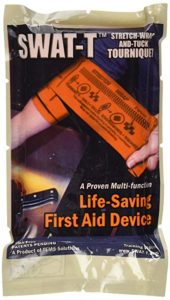
SWAT-T Tourniquets ($12.65 each)
https://www.amazon.com/gp/product/B00MYG9YA0/ref=oh_aui_detailpage_o09_s00?ie=UTF8&psc=1
Nearly two-thirds of preventable deaths in the SWAT/military operational environment are from extremity bleeding. The SWAT-Tourniquets (SWAT stands for Stretch, Wrap, and Tuck) allows a more rapid means to control extremity bleeding and allows application higher into the groin and axilla than most other tourniquets. Its ease of application is one of its greatest benefits, and individuals can effectively apply it in seconds with little to no prior training. It weighs only 4 ounces, and when folded in the package, measures just 4” x 3”. The other benefit of the SWAT-T Tourniquets is that it can be used as an elastic bandage, a pressure dressing/compression wrap, or as a tourniquet, and has stretch indicators to let you know when it has crossed over from a simple compression wrap to a tourniquet.
QuikClot Advanced Clotting Gauze with Kaolin (Two 3” x 24” Gauze Strips @ $19.97)
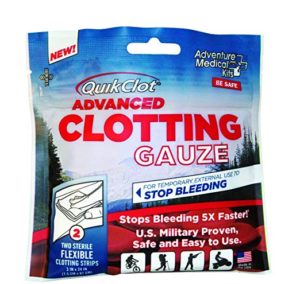
https://www.amazon.com/gp/product/B00HJTH5L2/ref=oh_aui_detailpage_o00_s00?ie=UTF8&th=1
With QuikClot Advanced Clotting Gauze, you have the power to stop bleeding quickly. Tested and proven through years of combat use by the U.S. Military, QuikClot can be depended on to save time when every second counts. The hemostatic gauze works on contact to stop bleeding by accelerating your body’s natural clotting process, clotting blood five times faster. This pack contains two gauzes impregnated with kaolin, a naturally-occurring mineral proven to be effective as a hemostatic agent. Inorganic and inert, kaolin is non-allergenic, making it safe and effective to use. QuikClot’s extremely absorbent gauze is flexible and pliable, easily contouring to wounds. This lightweight, extremely compact package contains two strips of QuikClot gauze (3” x 24”) and weighs less than 1 ounce.
ZipStitch Laceration Kit ($29.99)
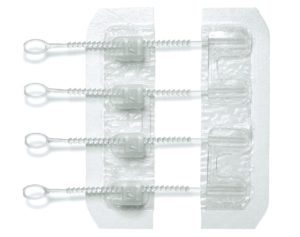 ZipStitch is the only surgical-quality wound closure device available without a prescription. With this product, you can treat cuts with hospital-grade technology when you can’t get to an ER for stitches. Since ZipStitch is completely non-invasive, you avoid the pain, hassle and out-of-pocket costs associated with a trip for stitches. ZipStitch comes in a convenient, easy-to-carry envelope with complimentary supplies to treat your wound including:
ZipStitch is the only surgical-quality wound closure device available without a prescription. With this product, you can treat cuts with hospital-grade technology when you can’t get to an ER for stitches. Since ZipStitch is completely non-invasive, you avoid the pain, hassle and out-of-pocket costs associated with a trip for stitches. ZipStitch comes in a convenient, easy-to-carry envelope with complimentary supplies to treat your wound including:
- Gauze pad to stop bleeding
- Alcohol wipe to clean wound area
- ZipStitch to close laceration
- Bandage to cover and protect closed wound
Each ZipStitch can close a wound up to 1.5 inches long, and weighs less than an ounce.
With these 3 additions to my elk hunting pack, I’m more confident that I’ll be prepared to treat more than just blisters and scrapes on future hunts. As elk hunters – especially archery elk hunters – we are exposed to sharp knives, broadheads, and a myriad of other sharp objects that can inflict deep, traumatic cuts in a matter of seconds. In addition to exercising caution in all that we do, I’ve learned it’s important to be prepared to deal with these emergencies. And while we may be lucky enough to never have it happen to us, being prepared for these situations might save the life of a hunting partner or someone else who isn’t quite as lucky.
